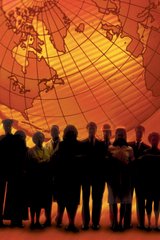 The national symbol of Korea is a red and blue circle showing the contrast between yin and yang. No other symbol is more appropriate. As the previous postings have indicated, Korea is a fully modern, prosperous nation, with a culture that is unique to the uninitiated Westerner. Seoul is huge and has all that can be offered in an area inhabited by 24 million people.
The national symbol of Korea is a red and blue circle showing the contrast between yin and yang. No other symbol is more appropriate. As the previous postings have indicated, Korea is a fully modern, prosperous nation, with a culture that is unique to the uninitiated Westerner. Seoul is huge and has all that can be offered in an area inhabited by 24 million people. But just 50 kilometers north lies the world's most heavily fortified border, considered by many to be one of the most dangerous places in the world. This division between the two Koreas is known as the Demilitarized Zone (DMZ) and it affectively divides a single nation, people, and culture.

When the Korean War ended in a stalemate in 1953, the generals drew the line there, in the center of the peninsula. In order to prevent further clashes, this 155 mile long, 2.5 mile wide buffer zone was established. The area consists of a seemingly endless series of barbed wire, bunkers, watchtowers, and artillery emplacements. Today, it is open to the public and my classmates and I had the opportunity to visit on our last week in Korea.
Smack in the middle of the DMZ, just between the fences, is the very epicenter of the Cold War era conflict between North and South Korea. Called Panmunjeom, but officially known as the Joint Security Area (JSA), this is the one place where North and South Korean soldiers can stand just feet from each other and, literally, stare face-to-face. There is a line in the middle, marking the respective sides. There are buildings on both sides and a number which straddle the line, one of which contains the conference table where officials from the North and South can meet. Anyone who crosses the line outside the conference building is considered to have defected. These defections do often occur and many situations have erupted in firefights.
As tourists, we were highly restricted in our activities. For one thing, only foreigners can go to the JSA. Koreans are simply not permitted. Other restrictions included no pictures, no talking without permission, and we had to stick to a respectable dress code (in case we ended up on North Korean propaganda posters; seriously). All of this was meant to prevent North Korean soldiers from misinterpreting our actions and starting an international incident. Perhaps most striking was the requirement that we sign a form waiving any claim for an injury caused by enemy or friendly fire.
When our bus pulled up to the South Korean building, we were quickly marched inside double-file. Then, we were rushed into the conference building. Once there, we were actually permitted to cross the line in the middle, which meant we were technically in North Korean territory. No funny business was allowed, especially under the watchful eyes of the South Korean and American soldiers. All of our touring took place while a North Korean soldier stood on his respective side and stared at us through his binoculars. The feeling there was very eerie. The silence was deafening and one could sense an almost crushing tension in the air.
On the ride back, I asked our tour guide why Koreans are not allowed to go to Panmunjeom. His revealing answer was that the place is very emotional for Koreans. This is understandable since many families were separated by the war. Also, the knowledge that Korea has been divided between a democratic, capitalist state and an Orwellian dictatorship is an item which haunts the Korean psyche to this day.
For anyone who visits Korea, I highly recommend the tour of Panmunjeom. Do it at the end, that way you can experience the tension and the stark contrast between North and South Korea.

No comments:
Post a Comment